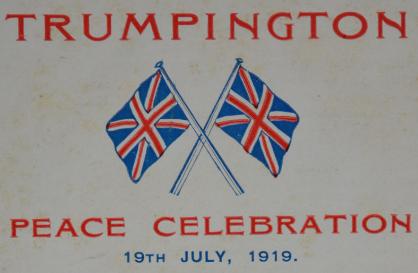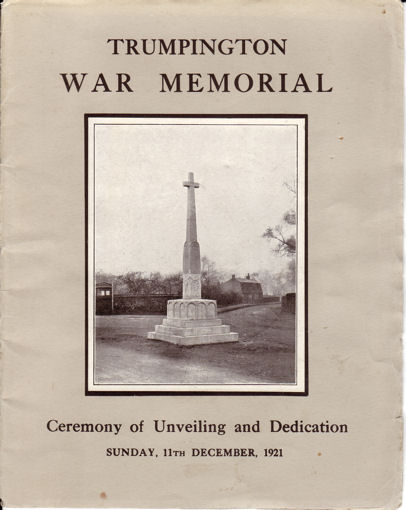Andrew Roberts
This paper describes peace-time activities in Trumpington after the end of World War 1. It was presented at the Local History Group meeting on 12 March 2020.

Peace celebrations, 1919-20
The First World War ended with the Armistice on the 11th hour of the 11th day of the 11th month, 11 November 1918. The Treaty of Versailles was signed on 28 June 1919 and Saturday 19 July 1919 was declared to be Peace Day and a Public Holiday in Britain.
Reports in local newspapers and the parish magazine described the Peace Day Celebrations in Trumpington. On Sunday 6 July 1919, there was a United Service of Thanksgiving in the Church. On 7 July 1919, the Parish Council began to make arrangements for the Peace Day event to be held just 12 days later. The celebration was free for children and demobilised soldiers, sailors and women, with others welcome on payment of 1/-. The Council arranged the programme for the day, and printed a commemorative card, a copy of which was bound into the file copy of the parish magazine held in the Church. This contained the overall programme, the sports programme and a list of all local men who were known to have joined the Forces. The activities included at 10 am a short thanksgiving service; 10.30 am cricket match on the Recreation Ground, Married versus Single (the Singles won); 2 pm onwards, 15 sports events on the Recreation Ground. There was tea in the large barn ‘kindly lent by Mr Duke’, first for children at 4 pm then a meat tea for adults at 5 pm, with about 600 people, with “plenty of food, although a little more sugar would have been acceptable”. In the evening, the grounds of Trumpington Hall and Anstey Hall were open to parishioners for dancing. A souvenir was given to demobilised men.
Sources: Cambridge Independent Press , 25 July 1919, p. 9; Cambridge Chronicle , 23 July 1919, p. 12 (see the newspapers page); Parish Magazine , ‘Peace Celebration 19th July 1919, Programme of arrangements’, July and ‘Peace Celebration’, September 1919.
!['Peace Celebration 19th July 1919, Programme of arrangements'. Parish Magazine, July 1919 [an insert bound into the magazine].](http://trumpingtonlocalhistorygroup.org/wp-content/uploads/ParishMagazine_5933_Jul1919-349x527-1.jpg)
!['Peace Celebration 19th July 1919, Programme of arrangements'. Parish Magazine, July 1919 [an insert bound into the magazine].](http://trumpingtonlocalhistorygroup.org/wp-content/uploads/ParishMagazine_5934_Jul1919-350x529-1.jpg)
!['Peace Celebration 19th July 1919, Programme of arrangements'. Parish Magazine, July 1919 [an insert bound into the magazine].](http://trumpingtonlocalhistorygroup.org/wp-content/uploads/ParishMagazine_5936_Jul1919-600x399-1.jpg)
Some members of the Forces were unable to be present at the Peace Day Celebrations on 19 July 1919. A further meat tea was arranged in the Village Hall on Saturday 17 July 1920. Over 40 people took part, including a number of men who had moved away from the village. T.H.J. Porter welcomed the men and thanked them for their service. A. Forbes responded on behalf of the men and mentioned how much they had appreciated the Christmas parcels. In the evening, a large number of parishioners took part in an event in the grounds of Anstey Hall, when Mrs Forbes presented the men with mementos and there was a concert and dancing.
Source: Parish Magazine, ‘Tea to returned soldiers’, September 1920.
Plans for a Memorial to the Fallen, 1919-21
Percy Robinson records how the Parish Council discussed how to perpetuate the memory of the men of Trumpington who gave their lives in the Great War. It agreed to call a meeting of Parishioners and this was held in the Village Hall on 8 May 1919, with T.H.J. Porter in the Chair and P.R. Robinson as Secretary. The meeting does not seem to have been completely successful, with the Vicar noting “it is a matter for great regret that there should have been so small and unrepresentative an attendance …” However, it was agreed that a memorial should be erected and a Committee was established to consider the options and report back to the parish. Percy Robinson lists the proposals as:
1. Tablet placed in the Church recording the names of the fallen.
2. Memorial cross be placed in the New Churchyard.
3. Cross erected on the Cross Hill.
4. Obelisk erected on the Cross Hill.
5. Clock tower and shelter be erected on the Cross Hill.
6. Memorial placed in a garden with tennis courts and other space for the furtherance of
sport.
7. In combination with a visible memorial, assistance to the disabled, or dependents of the fallen men should be assisted educationally
The Vicar thought that a cross or obelisk on Cross Hill was the most favoured.
Over a year later, the Committee called a further parish meeting on 24 June 1920. According to the Vicar, the Committee “had failed to agree and had no advice to give or proposal to make” and “after much desultory discussion the meeting adopted Mrs Wingate’s scheme” for a War Memorial in the form of a plain cross to be designed by Eric Gill. Percy Robinson records that “two models, one of a cross and one an obelisk, were on view, also the drawing for a plaque”, with the meeting decising in favour of the cross.
Sources: Parish Magazine, ‘Memorial for the fallen’, June 1919, ‘War Memorial’, August 1920; Percy Robinson’s notes on the War Memorial.
After this cautious start, the eventual design and construction of the Cross was a great success and lasting memorial to the War. The Cross was unveiled on Sunday 11 December 1921. A War Memorial was also placed in the Committee Room in the Village Hall, dedicated to ‘Men of Trumpington who served in the Great War 1914-1918’.
Sources: Ceremony of Unveiling and Dedication, Sunday 11 December 1921 , commemorative booklet; Percy Robinson’s notes on the War Memorial; Newspaper reports including Cambridge Chronicle, 14 December 1921, p. 8 (see the War Memorial and newspapers pages).
